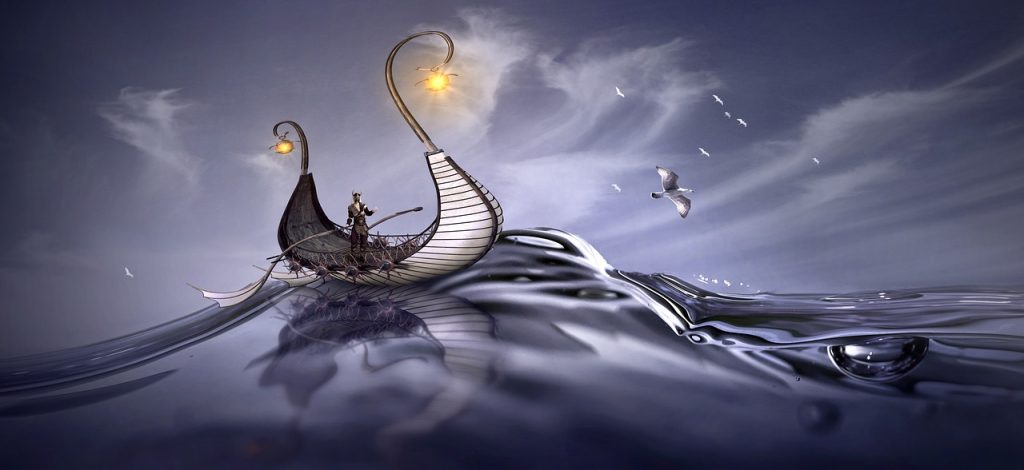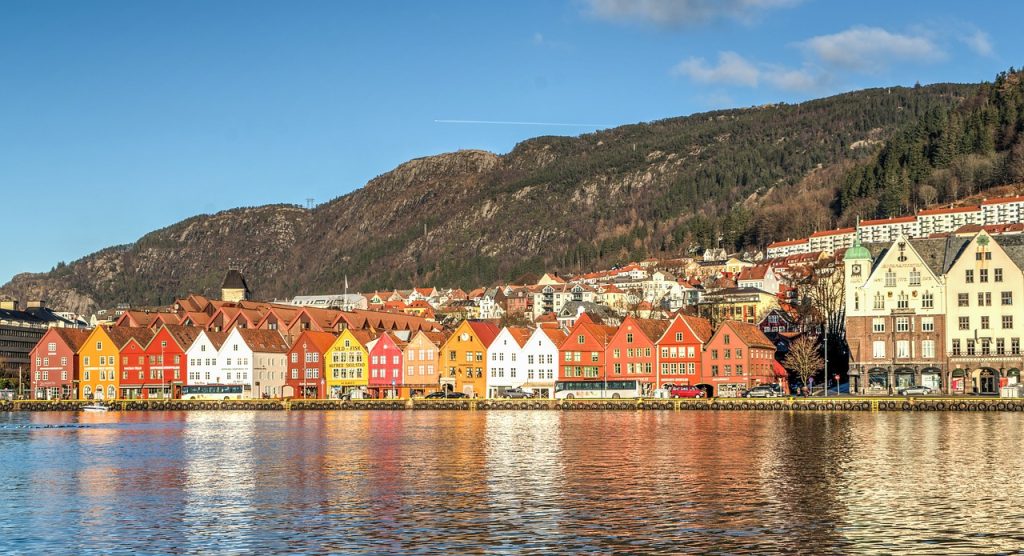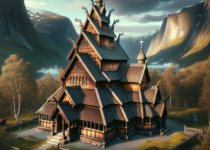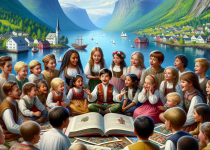A Journey Through Norwegian History: From Vikings to Modern Times
Norwegian history is filled with captivating tales of courageous explorers, rich cultural traditions, and transformative historical events. In this article, we will delve into some of the most essential aspects of Norway’s past, shedding light on how this Nordic nation became what it is today.
History of Norway Timeline: Key Moments and Events
The history of Norway spans thousands of years, but some key moments and events have played a significant role in shaping the nation we know today. These include the following:
- The Viking Age (c. 793–1066): During this period, Norwegian Vikings ventured across vast areas of Europe, earning a reputation as formidable warriors and skilled seafarers.
- The Union of Kalmar (1397–1523): Norway, Denmark, and Sweden formed a political union that lasted over a century, ultimately leading to Norway becoming a subordinate partner to Denmark.
- The Napoleonic Wars (1803–1815): After the conclusion of these conflicts, Norway was ceded to Sweden in the Treaty of Kiel in 1814. This marked the beginning of a short-lived period of independence and the drafting of the Norwegian constitution.
- The Union with Sweden (1814–1905): For nearly a century, Norway was in a union with Sweden, maintaining its institutions but sharing a king. This period ended peacefully with the dissolution of the union in 1905.
- World War II (1939–1945): Norway was occupied by Nazi Germany during the war, which led to a resistance movement and, eventually, liberation by the Allies in May 1945.
- Post-war period and modern times: Norway has since become a prosperous and peaceful nation, known for its high living standards, social welfare, and natural resources like oil and gas.
Vikings in Norway: Explorers, Warriors, and Settlers

The Vikings were an integral part of Norwegian history. These seafaring people ventured far and wide in search of trade, land, and new opportunities. Notorious for their military prowess, the Vikings left a lasting impact on European history, conquering and settling in regions such as the British Isles, France, and Russia. While the Viking Age was marked by violence and conquest, it also facilitated significant cultural exchange and trade.
Norwegian Kings and Queens: The Monarchy Through the Ages
Norway has a long history of monarchy, with several notable kings and queens who have left their mark on the nation. Among them are:
- Harald Fairhair (c. 850–c. 932): Often considered the first king of Norway, Harald is credited with uniting many smaller kingdoms under his rule.
- Olav II Haraldsson (995–1030), also known as St. Olav: As a patron saint of Norway, Olav played a significant role in the country’s conversion to Christianity.
- Queen Margaret I (1353–1412): As the ruler of Denmark, Norway, and Sweden, Margaret helped form the Kalmar Union, which united the three kingdoms for more than a century.
- King Haakon VII (1872–1957): The first king of independent Norway following the dissolution of the union with Sweden, Haakon was a symbol of national unity and resistance during World War II.
Norwegian Historical Landmarks: A Glimpse Into the Past
Norway is home to many historical landmarks that offer insights into the nation’s rich past. From ancient stave churches and Viking burial mounds to impressive fortresses and royal residences, these sites provide a tangible connection to Norway’s history and cultural heritage.
By exploring these different aspects of Norwegian history, we can gain a deeper understanding of the events, people, and forces that have shaped this remarkable Nordic nation. Whether it’s the intrepid spirit of the Vikings, the struggles of past monarchs, or the resilience of the nation during times of conflict, Norway’s history offers valuable lessons and unique perspectives on the world we live in today.
Norwegian Cultural History: Traditions and Influences
Norwegian cultural history is rich and varied, with influences from both its indigenous Sami population and the many nations with which it has interacted throughout the centuries. Art, music, literature, and folklore all contribute to the tapestry of Norwegian culture, which continues to evolve and adapt to modern times. Traditional Norwegian crafts, such as woodcarving and rosemaling (decorative painting), have been passed down through generations, while Norwegian folk music and dance continue to thrive in rural communities.
Norwegian Exploration and Expeditions: Pioneers of the Arctic
Norwegians have long been known for their exploration and expeditions, both during the Viking Age and in more recent history. Some notable Norwegian explorers include:
- Fridtjof Nansen (1861–1930): A renowned scientist, humanitarian, and explorer, Nansen made significant contributions to Arctic exploration and research.
- Roald Amundsen (1872–1928): Amundsen was the first person to reach both the North and South Poles, solidifying Norway’s reputation as a leader in polar exploration.
These explorers not only expanded our understanding of the world’s most remote regions but also inspired future generations to push the boundaries of human knowledge and achievement.
Famous Norwegians in History: Icons and Innovators
Throughout history, many Norwegians have made significant contributions to various fields, from science and exploration to the arts and sports. Some famous Norwegians include:
- Henrik Ibsen (1828–1906): A groundbreaking playwright and theatre director, Ibsen is the father of modern drama.
- Edvard Grieg (1843–1907): A celebrated composer and pianist, Grieg’s music has become synonymous with Norwegian nationalism and Romanticism.
- Edvard Munch (1863–1944): One of the most influential painters of his time, Munch is best known for his iconic work, “The Scream.”
By examining the lives and achievements of these notable individuals, we can appreciate the impact that Norwegians have had on the global stage and the enduring legacy they have left behind.
In conclusion, the rich tapestry of Norwegian history offers a wealth of insights into the nation’s past, from its earliest beginnings to its modern-day successes. By exploring the various facets of this compelling story, we can better understand the unique character and enduring spirit of the Norwegian people.
The Sami People: Norway’s Indigenous Culture
A Rich Cultural Heritage Spanning Thousands of Years
The Sami people, sometimes referred to as Laplanders, are the indigenous inhabitants of the northern regions of Norway, Sweden, Finland, and the Kola Peninsula in Russia. With a history dating back thousands of years, the Sami have a rich cultural heritage that includes traditional reindeer herding, distinctive handicrafts called “duodji,” and the unique Sami language with its multiple dialects.
Challenges and Preservation of Sami Culture
Sami culture has faced challenges over the years, with efforts to assimilate the Sami people into the dominant Scandinavian culture, land disputes, and the encroachment of modern society on traditional ways of life. However, the Sami have persevered and are now recognized for their unique contributions to Norwegian culture, with increased efforts to preserve their language, traditions, and rights as indigenous people.
See more: Sami Culture in Norway: A Deep Dive into an Indigenous Legacy
The Norwegian Resistance Movement During World War II
The Emergence of the Norwegian Resistance Movement
During World War II, Norway was occupied by Nazi Germany from 1940 to 1945. In response to this occupation, a Norwegian resistance movement emerged, which played a crucial role in undermining the German war effort and ultimately contributing to the liberation of Norway.
The resistance movement consisted of various groups, including the “Milorg” (military organization), the “Hjemmefronten” (home front), and various intelligence networks. These groups carried out acts of sabotage, collected intelligence, and provided support to the Allies.
The Heroes of Telemark: A Pivotal Moment in the Norwegian Resistance
The Norwegian resistance movement’s efforts culminated in the successful sabotage of the heavy water production facility at Vemork in 1943, which was crucial in preventing the development of a German atomic bomb. This event, known as the “Heroes of Telemark” operation, remains a source of national pride and a testament to the bravery and determination of the Norwegian people during a challenging time in their history.
The Discovery of Oil and Gas in Norway: A Modern Success Story
The discovery of oil and gas in the North Sea in the late 1960s and early 1970s marked a turning point in Norway’s history, transforming the nation into one of the world’s leading energy producers. The development of the oil and gas industry has had a profound impact on Norway’s economy, infrastructure, and society.
Managing Norway’s Oil Wealth: The Government Pension Fund Global
The Norwegian government has played an essential role in managing the nation’s oil wealth, establishing the sovereign wealth fund, also known as the Government Pension Fund Global. This fund, one of the world’s largest, is designed to secure long-term financial stability for future generations and ensure that the benefits of Norway’s oil and gas resources are shared among its citizens.
Environmental Responsibility and Sustainable Development in Norway
While the oil and gas industry has brought prosperity to Norway, it has also highlighted the need for environmental responsibility and sustainable development. As a result, Norway has become a global leader in renewable energy, with ambitious goals for reducing greenhouse gas emissions and promoting clean energy alternatives.
The Significance of Norway’s History: A Blend of Ancient Traditions and Modern Innovation
In summary, Norwegian history is a fascinating blend of ancient traditions, courageous exploration, and modern innovation. By examining the many aspects of this Nordic nation’s past, we can better understand its unique identity and the spirit of its people. From the Viking Age to the present day, Norway’s history serves as a testament to the resilience, determination, and ingenuity of those who call it home.
The Norwegian Constitution and National Day
May 17th is a significant date in Norwegian history, as it marks the signing of the Constitution of Norway at Eidsvoll in 1814. This event laid the foundation for Norway’s modern parliamentary system and established the nation’s independence from Denmark. Today, May 17th is celebrated as Norway’s National Day, or “Syttende Mai,” and is a source of national pride and unity.
National Day festivities include parades, traditional costumes called “bunads,” and various events that showcase Norwegian culture and history. The celebration is an opportunity for Norwegians to express their patriotism and reflect on the country’s journey toward independence and democracy.
The Norwegian Language: A Rich Linguistic Heritage
Origins and Forms of the Norwegian Language
The Norwegian language is a North Germanic language that shares many similarities with Danish and Swedish. It has a rich linguistic history, with roots in Old Norse, the language spoken by the Vikings. Today, there are two official forms of written Norwegian: Bokmål and Nynorsk.
Bokmål and Nynorsk: Norway’s Official Written Forms
Bokmål, the more widely used of the two forms, is closely related to Danish due to Norway’s historical ties with Denmark. Nynorsk, on the other hand, was developed in the 19th century as an effort to create a written language that was more reflective of Norwegian dialects and less influenced by Danish. Both forms are used in education, media, and government, and Norwegians are generally able to understand and communicate in both.
Regional Dialects: Preserving Norway’s Linguistic Heritage
In addition to Bokmål and Nynorsk, Norway is home to a diverse range of regional dialects, which are spoken and cherished by communities across the country. The preservation and promotion of these dialects contribute to Norway’s rich linguistic heritage and cultural diversity.
The Norwegian Fjords: A Natural Wonder

Norway’s landscape is renowned for its breathtaking fjords, which are steep, glacially-carved valleys filled with seawater. These stunning formations are the result of millions of years of geological processes and are among the country’s most iconic and beloved natural features.
Exploring the Fjords: Tourism and Unique Attractions
The fjords attract millions of tourists each year, who come to marvel at their beauty and experience the unique activities and attractions they offer. Popular fjords include Geirangerfjord, Nærøyfjord, and Sognefjord, which are all part of the West Norwegian Fjords UNESCO World Heritage Site. Visitors can explore the fjords by taking scenic cruises, hiking along picturesque trails, or visiting charming villages nestled along the fjord’s shores.
The Role of Fjords in Norwegian History and Culture
The fjords also hold cultural significance for Norwegians, as they have been home to communities and trade routes for centuries. The fjords have played an essential role in shaping Norwegian history, and their continued preservation is vital for the country’s natural beauty and cultural heritage.
Norwegian History: A Rich Tapestry of Exploration, Resilience, and Innovation
In conclusion, the diverse and captivating aspects of Norwegian history provide a fascinating lens through which to understand this Nordic nation’s past and present. From ancient times to modern achievements, the story of Norway is one of exploration, resilience, and innovation. By appreciating the rich tapestry of its history, we can develop a deeper understanding of the unique character and spirit of the Norwegian people, who continue to make their mark on the world.
The Hanseatic League and Bergen: A Flourishing Trade Center

Between the 14th and 16th centuries, the Hanseatic League – a powerful confederation of merchant guilds and market towns – played a significant role in shaping Norway’s economic and political landscape. Bergen, Norway’s second-largest city, became a vital trade center within the Hanseatic League, and its port, Bryggen, was a bustling hub of commerce and cultural exchange.
The Role of Bergen and Bryggen in the Hanseatic Trade Network
The Hanseatic merchants, mainly from Germany, established a thriving trade in fish, particularly stockfish (dried cod), which was in high demand across Europe. In exchange, they brought essential goods such as grains, textiles, and other commodities to Norway. This trade network had a lasting impact on Norwegian society, fostering economic growth and shaping the nation’s urban development.
Bryggen: A UNESCO World Heritage Site Reflecting Norway’s Hanseatic Past
Today, the historic district of Bryggen in Bergen stands as a UNESCO World Heritage Site, with its colorful wooden buildings providing a glimpse into the city’s rich Hanseatic past. Visitors can stroll through the narrow alleyways, explore the old merchant houses, and learn about the fascinating history of this once-thriving trade hub.
The Legacy of the Hanseatic League in Modern Norway
The influence of the Hanseatic League can still be felt in modern Norway, as it played a crucial role in the nation’s economic and cultural development. The legacy of this powerful trade network highlights the importance of international cooperation and exchange, which continue to drive progress and innovation in Norway and beyond. By preserving and celebrating its Hanseatic heritage, Norway honors the spirit of entrepreneurship and collaboration that has shaped its history.
Offical website: https://en.visitbergen.com
The Stave Churches: Architectural Treasures from the Middle Ages
The stave church is one of the most unique and iconic elements of Norwegian history and architecture. These wooden churches, dating back to the Middle Ages, feature intricate carvings, post-and-beam construction, and stunning design elements that blend Christian motifs with traditional Norse art styles.
At their peak, there were likely more than 1,000 stave churches in Norway. Today, only 28 remain, with the oldest – Urnes Stave Church – dating back to around 1130. These remarkable structures serve as important links to Norway’s medieval past and showcase the craftsmanship and artistry of the era.
Visiting a stave church is a fascinating journey into Norwegian history, offering insights into the nation’s spiritual and cultural heritage. Preservation efforts continue to ensure these architectural treasures remain for future generations to appreciate and explore.
Official website: https://www.stavechurch.com/
The Nobel Peace Prize: Norway’s Commitment to Peace and Diplomacy
Instituted by the will of Swedish inventor and industrialist Alfred Nobel, the Nobel Peace Prize has been awarded annually since 1901. While the other Nobel Prizes are presented in Sweden, the Peace Prize is awarded in Oslo, Norway, a testament to the nation’s commitment to peace and diplomacy.
Honoring Contributions to Peace and Conflict Resolution
The Nobel Peace Prize honors individuals and organizations that have made significant contributions to peace and conflict resolution, highlighting Norway’s role as an advocate for peace and international cooperation. The award ceremony takes place each year on December 10th, the anniversary of Alfred Nobel’s death, and is attended by the Norwegian royal family, government officials, and prominent guests from around the world.
Norway’s Dedication to Promoting Peace and Global Collaboration
By hosting the Nobel Peace Prize, Norway reinforces its dedication to promoting peace, understanding, and global collaboration, further solidifying its place on the international stage as a champion for these ideals.
Exploring the Multifaceted History of Norway
In conclusion, the multifaceted history of Norway presents a captivating narrative that encompasses a wide range of topics, from ancient traditions and exploration to modern innovation and diplomacy. By delving into the myriad aspects of this Nordic nation’s past, we can develop a deeper appreciation for the unique character and spirit of the Norwegian people, who continue to shape the world in countless ways.
Official website: https://www.nobelprize.org
- Norwegian Myths in Modern Media: From Literature to Video Games - August 20, 2024
- Urban Farming in Norway: Green Spaces in the Heart of the City - August 14, 2024
- Norwegian Legends: The Enigmatic Sea Serpent of Seljord - August 13, 2024


